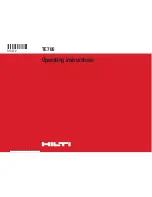
7
• Always position the wrench for maximum
stability. Use the positioning handle to
properly position tool during operation.
• Be sure reaction points are adequate for
the forces at work during operation of
the tool.
• Be sure the reaction point is of a suitable
shape. If possible, use an adjacent nut or
bolt as a reaction point.
• When the hex socket is placed on the
nut or bolt a gap may exist between
the reaction foot and the reaction point.
When the tool is operated the reaction
foot and point will make forceful contact.
Be sure the wrench is stable before
applying hydraulic pressure.
• Provide adequate support in vertical and
inverted applications.
• The torque required to loosen a nut is
variable and may exceed the torque
capacity of the wrench. Never operate
the wrench at above 75 percent of its
rated maximum torque when loosening a
nut or bolt.
• Be sure to minimize torsional and
bending stresses in the wrench, the hex
socket and any accessories.
• Bolt lubricants and anti-seize
compounds will have a rated coefficient
of friction. Be sure to know the
coefficient of friction for the lubricant
or anti-seize compound that is being
used. To ensure proper tightening of nuts
and bolts, always use this coefficient of
friction when calculating required torque
values.
NOTICE
Failure to observe and comply with the
following precautions could result in
property damage and/or void the product
warranty.
• Never carry the wrench by its hoses.
• Always use Enerpac pumps and hoses.
• Always use Enerpac replacement parts.
• The maximum torque output of the
wrench must always exceed the torque
required to loosen or tighten the nut or
bolt.
• Never operate the wrench with a
hydraulic supply connection to the
advance side only as this may damage
the internal parts.
• In severe service conditions, be aware
that the wrench must be inspected,
cleaned and lubricated more frequently
than normal (see Section 5).
• Check that the swivel post screws are
tight prior to use. (see Section 5)
• If oil leakage is present from wrench,
replace seals as required (see Section
5) before placing the wrench back into
service.
• If the wrench is dropped from a
significant height, have the tool
inspected and checked for proper
operation before placing it back into
service.
• Always follow the inspection and
maintenance instructions contained in
this manual. Perform maintenance and
inspection activities at the specified time
intervals.
ENGLISH








































